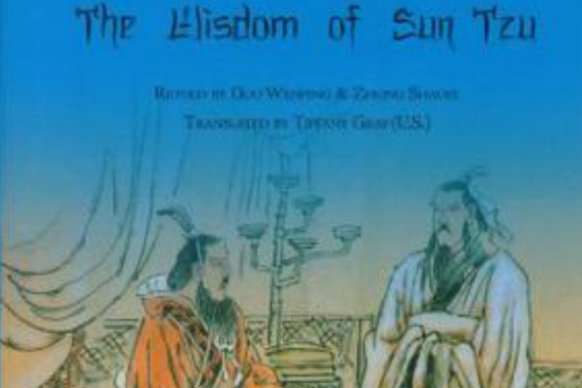
孫子的智慧(2010年五洲傳播出版社出版的圖書)
相關詞條
- 孫子的智慧(2010年五洲傳播出版社出版的圖書)
《孫子的智慧》是2010年五洲傳播出版社出版的一本書,作者是郭聞平,鐘少異。內容簡介 《孫子的智慧(英文版)》內容簡介:Sun Tzu' s The Art of War is a Chinese military treatise that was written by Sun Tzu in the 6th ...
- 孫子的智慧(2018年五洲傳播出版社出版的圖書)
孫子的智慧 《孫子的智慧》是2018年五洲傳播出版社出版的圖書。
- 孫子智慧
《孫子智慧》是2015年山東人民出版社出版的圖書。內容簡介 《孫子兵法》蘊藏富足的不朽智慧,既涵蓋了軍事、兵法之域,然而又旁通於人生、處世之維度,而且這些智慧的生命力特強,可以為各領域裡的祈望奮鬥而勝出者,提供有益的佑助。確...
- 孫子的智慧:英文
孫子的智慧:英文 《孫子的智慧:英文》是2011年五洲傳播出版社出版的圖書。作者簡介 本書用通俗的語言和貼切的案例故事將《孫子兵法》詮釋得頗有趣味,讀者不僅可以體會孫子的兵法精髓,也能了解到孫子的生平事跡及其歷史影響。
- 孫子的管理智慧:老闆與孫子的對話
《孫子的管理智慧:老闆與孫子的對話》是2011年中國經濟出版社出版的圖書,作者是陳世清。內容簡介 講述了:習孫子的管理智慧,就是要把孫子的管理智慧移植到現代的管理模式中,減少經營活動中的盲目性,提高經營活動中的自覺性,自覺地用...
- 孫子兵法智謀故事總集
由於《孫子兵法》的影響,他被人稱為"兵聖"。《孫子兵法》充滿了謀略的智慧。春秋戰國時期,軍事家常引用《孫子兵法》作為自己的軍事行動的理論根據。漢代以後,《孫子兵法》更是被軍事家視為指導戰爭的金科玉律,在整個冷兵器為主的漫長...
- 孫子智慧故事
孫子生平 孫子智慧故事 1.出其不意——吳楚柏舉之戰 2.虛虛實實——孫臏智擒龐涓 3.利而誘之——齊、鄭大敗北戎 4.攻其不備——齊討蔡伐楚 5.親而離之——晉獻公假道伐虢 6.逸而勞之——楚莊王疲敵平內亂 7.以仁激勇...
- 孫子兵法智慧
《孫子兵法智慧》是2011年中國商業出版社出版的圖書,作者是孫武。內容簡介 《孫子兵法智慧》內容簡介:西方人早就注意到,“要在亞洲成功,除非有特別的賄賂技巧和尋求自我保護的本領,否則很難生存下來”,因此,他們發現了古老兵法中的...
- 孫子兵法·謀攻篇
《孫子兵法·謀攻篇》是春秋時期兵法家孫武創作的一篇散文,出自《孫子兵法》。原文 孫子曰:夫用兵之法,全國為上,破國次之;全軍為上,破軍次之;全旅為上,破旅次之;全卒為上,破卒次之;全伍為上,破伍次之。是故百戰百勝...
- 孫子兵法三十六計智謀全解/超值典藏書系
《孫子兵法》為春秋時代著名軍事家孫子所著,是我國古代最早也是最著名的一部軍事著作。全書十三篇,從十三個方面詳細講述了行軍打仗的要訣與智謀。《三十六計》是我國古代一部講述戰爭謀略的智慧讀本,它對我國古代的鬥爭經驗和軍事思想...
- 孫子兵法智謀三百
《孫子兵法》的社會影響已遠遠超出軍事學領域,備受各國企業家、外交家、政治家、經濟學家的青睞。它既可用於重大戰爭前的決策參謀,又能為個人處世為人出謀劃策。它是我們中華民族對全人類智慧寶庫奉獻的珍品。我們在仔細研讀了《孫子...
- 孫子兵法智慧新解
《孫子兵法智慧新解》是2007年地震出版社出版的圖書,作者是韋明輝。內容提要 本書是一本系統介紹孫子軍事謀略思想及其古今套用的知識性讀物,全書包括孫子十三篇原文、翻譯、簡介以及實踐套用四大部分,從多個側面、全新角度向人們揭示了應該...
- 孫子大講堂:孫子的兵戰謀略
因此,從這一方面來解讀孫子的兵法謀略是有著巨大價值和空間的。本書正是以孫子的兵法謀略為底料,從《孫子兵法》中汲取智慧,試圖將孫子的兵法謀略與現代商戰有機結合在一起,為廣大讀者朋友編寫一本商戰謀略全書。一部論語可治天下,...
- 孫子兵法智慧名言故事
孫子兵法智慧名言故事 《孫子兵法智慧名言故事》是2009年出版的圖書,作者是張樹驊、張頌之。
- 跟孫子學智謀
它講的是兵法,說的確是智慧和謀略的運籌之術;故而,無論是在戰場還是商場、職場,都能有它的用武之地!跟著孫子學智謀,無與倫比的戰爭藝術,馳騁商場的錦囊妙計!目錄 前言/1 第一章計篇 1.兵不厭詐/3 2.攻其不備/6 ...
- 孫子兵法的智慧
《孫子兵法的智慧》是2007年遠方出版社出版的圖書,作者是王再華。內容簡介 聆聽聖旨教誨,汲取人文給養。感受生命關懷,接受智慧啟迪。《孫子兵法》是我國古代最著名的軍事著作,也是世界上最古老的兵書,有著豐富而深刻的思想內涵,閃爍著...
- 商道博弈:孫子兵法中的商業智慧
《商道博弈:孫子兵法中的商業智慧》是2010年新世界出版社出版的圖書,作者是孫武。內容簡介 《商道博弈:孫子兵法中的商業智慧》內容簡介:近三千年來,《孫子兵法》一直被尊為“兵學聖典”、“百世兵家之師”,享有“世界第一兵書”的...
- 孫子兵法的行銷智慧
行銷與銷售的裨是市場競爭,而《孫子兵法》正是詮釋競爭規律的頂尖之作!本書的作者傑拉德.A.麥可森是世界一流的《孫子兵法》行家,也是美國著名的市場行銷專家。作者長期從事《孫子兵法》的套用研究工作,對於如何把孫子的思想智慧套用...
- 孫子兵法的心理智慧
孫子兵法的心理智慧 《孫子兵法》是我國古代流傳下來的最早、最完整、最著名的軍事著作,是中國古代軍事文化遺產中的璀璨瑰寶,是人類取之不盡、用之不竭的謀略寶庫。 本書在《孫子兵法》的理論基礎上,將戰爭謀略與人生智慧結合在一起...
- 孫子兵法智慧全集
《孫子兵法智慧全集》是2007年群言出版社出版圖書,作者是吳學剛。中文名 孫子兵法智慧全集 [1] 作者 吳學剛 出版社 群言出版社 出版時間 2007年11月 頁數 334 頁 定價 42.8 元 ISBN 9787800807763 ...
- 孫子兵法與為人處世/孫子兵法智慧精華
孫子兵法與為人處世/孫子兵法智慧精華 《孫子兵法與為人處世/孫子兵法智慧精華》是2003年蘭州大學出版社出版的圖書,作者是陳才俊。
- 孫子兵法的博弈智慧
《孫子兵法的博弈智慧》是一本2022年中國紡織出版社有限公司出版的圖書,作者是王衡。 內容簡介 《孫子兵法》是春秋時期祖籍齊國樂安的吳國將軍孫武所著兵法著作,已有2500年歷史。其內容博大精深,思想精邃富贍,邏輯縝密嚴謹,是古代軍事...
- 孫子兵法與三十六計的智慧:典藏版
孫子兵法的智慧 第一篇始計篇 第二篇作戰篇 第三篇謀攻篇 第四篇軍形篇 第五篇兵勢篇 第六篇虛實篇 第七篇軍爭篇 第八篇九變篇 第九篇行軍篇 第十篇地形篇 第十一篇九地篇 第十二篇火攻篇 第十三篇用間篇 三十六計的...
- 孫子的戰爭智慧
《孫子的戰爭智慧》是2009年百花洲文藝出版社出版的圖書,作者是鐘少異。內容簡介 《孫子兵法》問世於公元前6世紀末,它是中國也是世界現存最古老的軍事理論著作。關於這部書及其作者孫子,中國明朝的軍事著作家茅元儀(公元1594~約1644年)...
